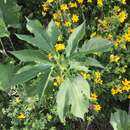Comprehensive Description
provided by North American Flora
Ambrosia aptera DC. Prodr. 5: 527. 1836
Ambrosia trifida texana Scheele. Linnaea 22: 156. 1849.
A tall annual, 1-5 m. high; stem angled, striate and scabrous; lower leaves deeply 5-cleft, the upper 3-cleft or simple, scabrous on both sides; petioles 5-15 cm. long, wingless; leaf-blades of the lower leaves orbicular in outline, 1-2 dm. long, the upper rhombic or ovate; divisions often 2-3-lobed, ovate, toothed; staminate heads numerous, in terminal racemes or panicles; involucre saucer-shaped, 3 mm. broad, with 3 dark ribs on the upper side and hispidulous on the portion between these ribs, otherwise glabrous, with 6-8 rounded lobes; paleae of the receptacle rudimentary; corolla glabrous, with 2 or more of the angles dark -colored ; pistillate heads in small clusters on the lower part of the racemes, subtended by linear leaves or sometimes by partly united involucral bracts; body of the fruit obovoid, about 4 mm. long, with 4-8 obtuse ridges and pitted in the intervals, with as many small or obsolete tubercles; beak conic, 1 mm. long.
Type locality: "Near Bejar, Mexico" [now Bexar, Texas].
Distribution: Lousiana and Mississippi to Arizona, Sonora, and Chihuahua.
- bibliographic citation
- Per Axel, Rydberg. 1922. CARDUALES; AMBROSIACEAE, CARDUACEAE. North American flora. vol 33(1). New York Botanical Garden, New York, NY

